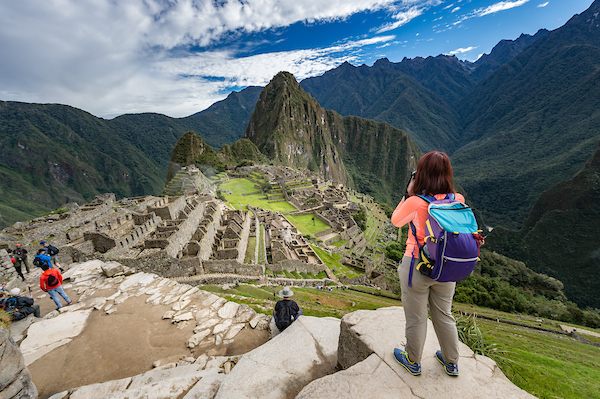Living Gluten Free in Peru


For the past couple of months, Sophie has been adapting her gluten- and dairy- free lifestyle to Peru; one of the most food-focused countries in the world. Sophie has celiac disease and is lactose intolerance. In Lima there is increasing awareness of dietary restrictions and a growing market for gluten- and dairy-free products. However, it still hasn’t reached the same level of popularity as in the US. So, Sophie has had to adjust through research and constant questions to ensure she isn’t eating something allergy triggering.
Pre- and Post-Arrival Food Anxieties
“Before coming to Peru, I was a little nervous about being gluten free, more so than dairy,” Sophie explained. Luckily, however, she shared, “I knew that a lot of staple foods were are all gluten-free friendly”. Sophie was more worried about the local’s attitudes and misconceptions of being gluten free than about the food itself; as she knew about the Peruvians’ zealous passion for their favorite dishes. “I had heard that because food is such an important thing in Peru, a lot of chefs will tell you there’s no gluten so that you can still enjoy the food; not realizing that celiac is a serious allergy,” she remembered.
Yet, upon arriving in Lima, Sophie quickly located places to eat close by her homestay that understood her dietary needs. “Right next to my house there are about 3 cafes that are 100% gluten and dairy free,” she excitedly imparted. “Also, most restaurants, if you tell them you have an allergy, are pretty understanding. It’s relatively easy to find something to eat at every restaurant, given that most food is made from corn, rice, quinoa, beans, or potatoes.”
However, “I get tired of explaining my allergies over and over again and being misunderstood (which happens the same way in the US) so I tend to not eat out”. Especially during Sophie’s first few weeks in Lima, “It was hard to adjust to eating out more; reading menus carefully and making sure the waiter or chef understood the severity of my allergy”. This was unavoidable because of the cheap food in Peru and subsequent culture of eating many meals a week out.
Struggles Eating Gluten Free in Lima
“The hardest part about eating gluten free in Peru is that oftentimes the restaurant staff here are so proud of the food; and they want you to be able to eat it—which is a very nice thought. However, if you have an allergy, that is not the greatest thing. They’ll tell you it’s gluten free and give it to you when it has gluten in it”. That is clearly a problem. Additionally, “I’m not really able to prepare my own meals as often as I’m used to”. She observed, “And when I make my own meals, I know it’s gluten free”. Instead, “Here it’s a lot more eating out and communicating with restaurant staff who might not even know what celiac is”.
Another frustrating and recurring situation is that, “Sometimes—if you say you have a gluten allergy—to be extra careful the restaurant staff will just tell you that everything on the menu has gluten in it, which is just not true,” she vented. “These are common things that happen in the US as well. So, in a way, it has just been a continuation here of what I deal with in the US. The big difference is not cooking for myself”.
Help Eating Gluten Free in Lima
Facilitating things, “My homestay has made eating gluten free easier. I know that my host parents understand my allergy and are very careful about it. So, I don’t have to ask any questions when it comes to foods that are prepared in my homestay because there is a common understanding about my allergy,” Sophie shares thankfully. “I can trust that what I’m being fed there is 100% gluten free”. Having a hand in all of this, “IFSA has helped me by working to convey my allergies at restaurants and with my host family,” she reflected. “Even during group meals, IFSA has strived to get me nutritious alternative options during group meals. This is important because it’s easy to just throw a simple salad at someone who is gluten free but that can end up leaving them hungry or even malnourished if repeated over time.”
Celiac Suggestions
“Definitely if you have celiac or just a gluten intolerance, eating in Lima really is not hard,” Sophie reassured. “In fact, a lot of times it can be easier than in the States. As I said, there are a lot of places here that will say on the menu “gluten free” and list all the allergens that might be in the food”. Offering examples, she happily imparts, “There are a lot of cafes that are clearly marked as completely gluten free; such as La Casa del Celiaco, Armónica and another called Huh”! Not to limit the options, she adds, “Something I would recommend is that when you get your homestay, look up places that have gluten-free food. Always look at reviews if you are going to go eat out. Don’t buy things off the street because there is no indication that it is definitely gluten free”.
While this may be new to many gluten-free eaters in the US, Sopie insists, “Even if you don’t have celiac, I would recommend saying you do. It’s a more common thing to say than just “I’m gluten free”. If you just say that, they might think it’s a preference or not completely understand. Offering some daily survival vocabulary for gluten-free Spanish-learners, “Practice the line: ‘soy celiaco/a entonces no puedo comer gluten’”. “Explain to them that it is a true allergy,” she emphasizes. “And even tell them that it could be fatal, even if that isn’t true, because that way it really hits home.”
Chris H. | International Affairs major | George Washington University | Pontificia Universidad Católica del Perú Partnership | Spring 2019 | IFSA International Correspondent